For my final assignment in CEP 818, I have written a white paper which lays out an argument for creativity following the seven cognitive tools presented in Sparks of Genius The 13 Thinking Tools of the World’s Most Creative People. I have also created a short elevator pitch and Twitter message to support my thinking.
CEP 818
How Do I Love Thee: Play
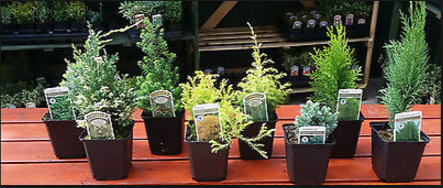
For this activity, students would begin to explore the idea of plants through a playful scavenger hunt. To begin, the teacher would have several stations set up around the classroom. Each station would include a different kind of plant with a number. The teacher would be sure to include plants with differing characteristics (textures, smells, etc.). Some examples might be flowering plants, algae, moss, and conifers. You might even throw in some plants that we eat like celery. First, ask students to move around the room and just observe the plants. Ask them, what do you notice? Bring students back together and have them share their observations. Next, engage students in a playful scavenger hunt, where they are using their senses to make observations about the plants. The scavenger hunt will ask students questions such as:
- Can you find the plant that looks sharp?
- Can you find the plant that smells like mint?
- Can you find the plant that feels like felt?
There are no wrong answers as long as students can explain their reasoning. If time permits, students could create their own scavenger hunt for another classmate to complete. After playing, ask students “What do you wonder”?
My understanding of the cognitive tool of play is that it is engaging in an activity that helps people to make sense of the world around them. Play happens in so many different ways in the educational setting. It is often looked at as “childish”, yet there is so much that can be learned through play. In reference to play, psychologist Jean Piaget states “it strengthens various mental skills” (Root-Bernstein, 1999). Play teaches us about the world around us. It is often embraced by our youngest learners, but unfortunately becomes almost non-existent as our students grow. This module has reminded me how important it is to incorporate play into our daily practice as educators.
The introductory activity I have created is playful because it is an exploratory game. This activity fosters curiosity and encourages students to think, question, and wonder about the world around them. It is related to the content in a meaningful way. The purpose of the activity is to introduce students to the topic of plants. Students are exploring with real plants to get them thinking about the material and to make their own connections.
This play-based activity is a great way to get students interested in the topic of plants. It allows students to explore the topic with a limited amount of structure. Students are encouraged to look for similarities, differences, and patterns.Through the scavenger hunt, students may begin to notice things they didn’t notice before. This activity gets students thinking about what makes a plant a plant. As students are engaged in this purposeful play, we are able to tap into their natural inquisitiveness. The Root-Bernsteins state “play transforms knowledge and builds understanding” (1999, p.268). No matter what children are playing, they are learning and participating in something of value.
References
Root-Bernstein, R. S., & Root-Bernstein, M. (1999). Sparks of genius: the 13 thinking tools of the world’s most creative people. Boston, MA: Houghton Mifflin.
Architecture of Space
Part I
The space that I chose to explore for this assignment is my classroom. Out of all the places I regularly visit, I would consider this space to be the most “conducive to creativity”. My classroom has always been a special place for me. It is where I spend my days, so each year I put a lot of effort into the design elements of the space. I work, play, think, create, explore, teach, and learn here, but I am not alone. This space is shared by 31 other people every day. When I actually stop and think about the events that take place in this space I am amazed. It is consumed by happiness, sadness, love, hate, hope, desire, dreams, humor… I could go on and on. This space is special to me mostly because of the people that I share it with. I know that the architecture of the space matters. We must accomplish a lot in this small space so the design must be productive for our kind of work. Below you will find pictures from my classroom with an explanation of what each area adds to the space to make it usable in our context.
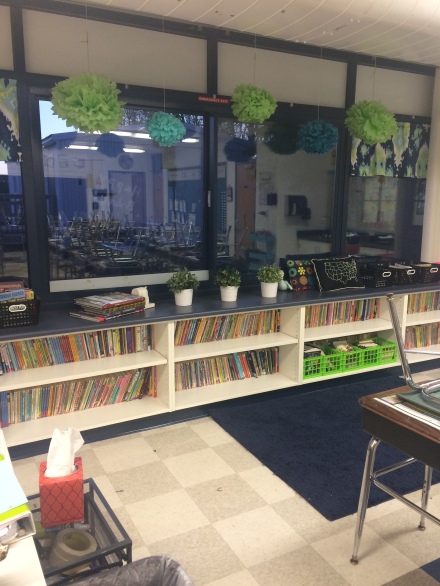
The space is homey. There are rugs, curtains, plants, and pillows, which all make the space more inviting and comfortable. The large window provides great natural light. The book shelves are low, where they are easily accessible to students.
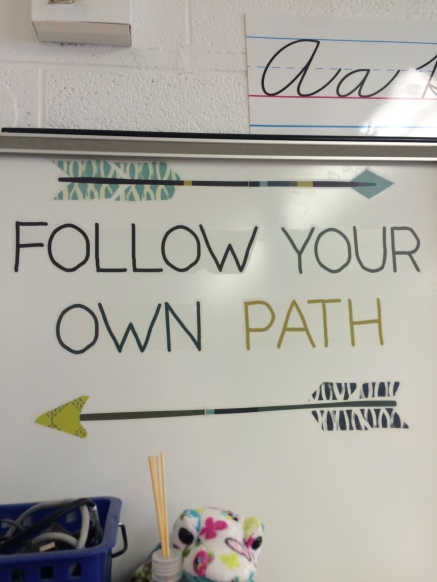
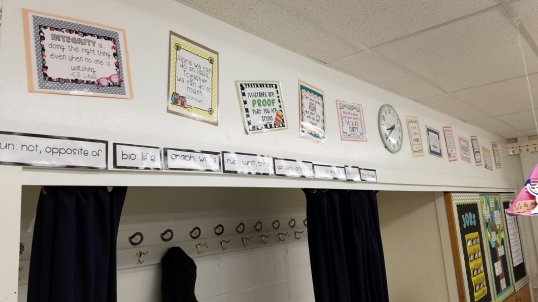
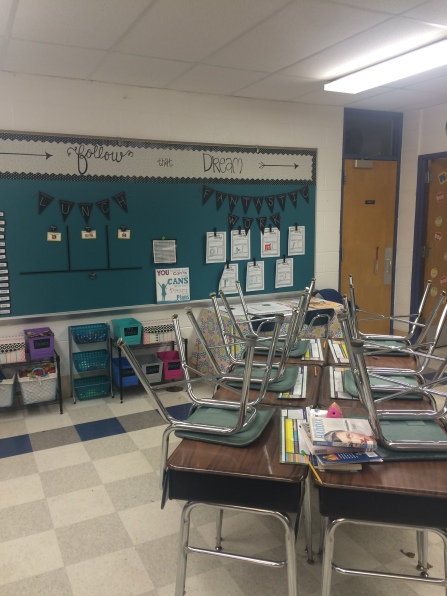
The space is inspiring. There are motivational quotes all around.
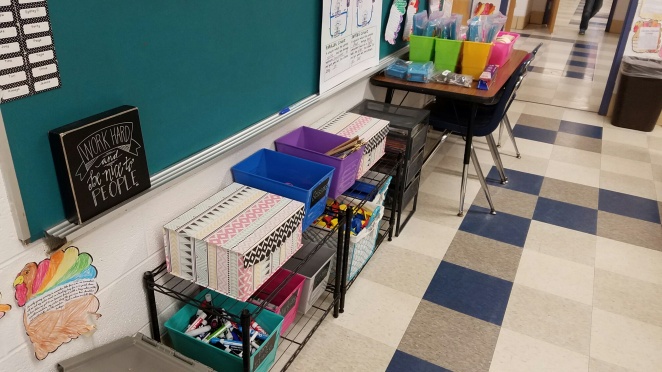
There is an array of supplies available. They are easily accessible and organized.
Student work is displayed. This helps students feel valued and motivated.
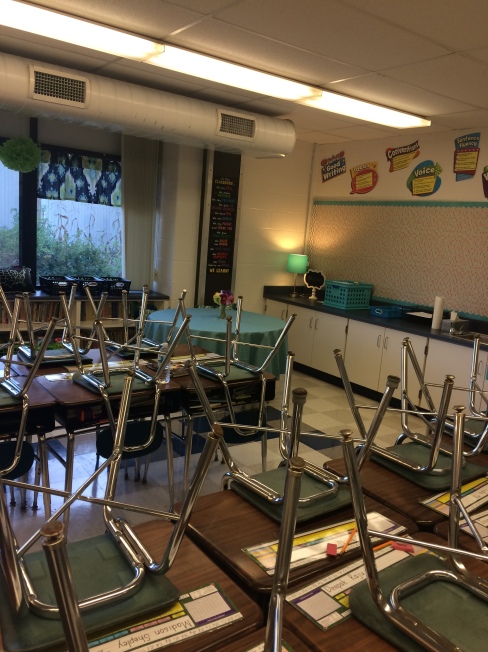
The round table is great for collaborative work. There are other flexible seating options around the room (beanbags, small carpets, pillows, small work tables). We have a table that doubles as a whiteboard, so we can write right on the surface of the table (great for small group work).
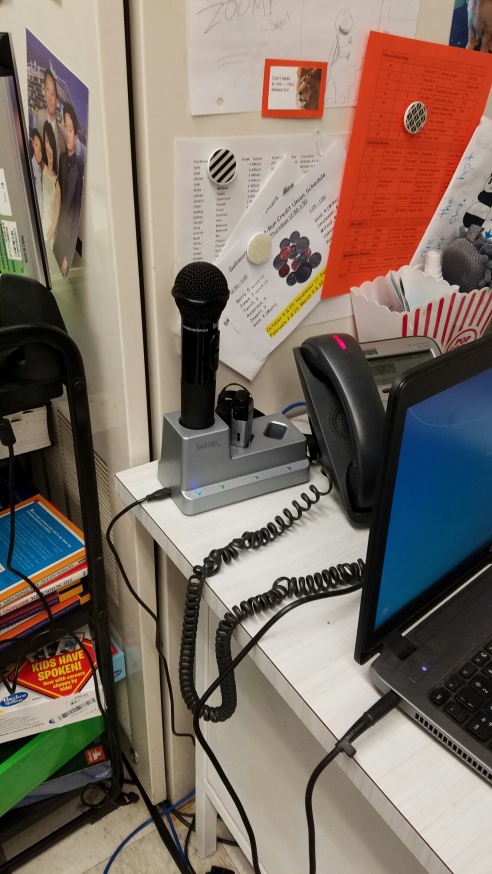
The microphone allows everyone’s voice to be heard.
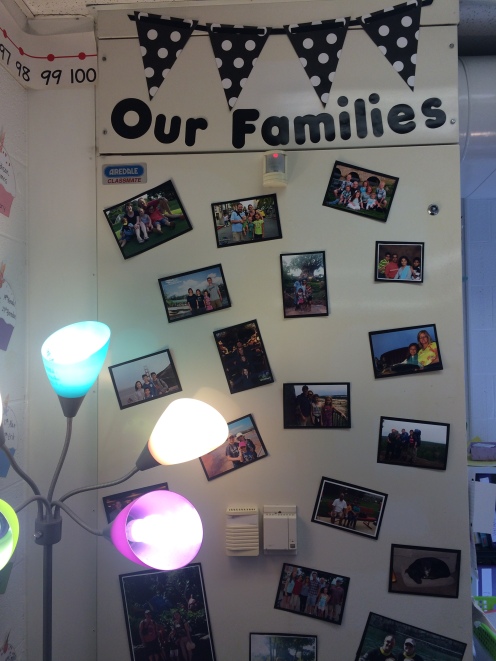
The family wall ensures that everyone feels welcome and connected.
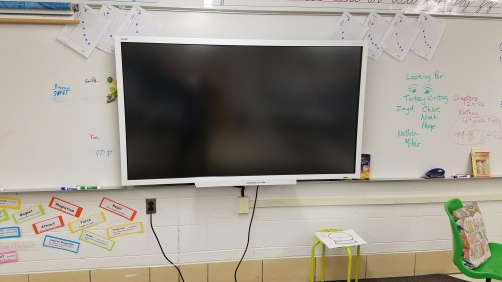
The SMARTboard is engaging and opens up learning to an unlimited number of possibilities.
Part II
After reading A Room of Their Own, I really got to thinking about my own classroom and the way the design elements of the space affect my students (they are after all, the main users of the space). Each summer, when I return to my classroom, I reconsider the design of the space to best fit the needs of my students and myself. I often move things around and switch things out to “make it better”. The key here is that this is my idea of better. I have never really considered what it would be like to have students design the space with me. In the article, the authors state “they took ownership over the space, and through flexibility, creativity and ingenuity, came up with solutions that best fit their learning and teaching goals and purposes” (p.7, 2013). It only makes sense then to engage students in the process of classroom design to create an environment that works best for everyone.
It is an interesting time for me to consider this, as one of my coworkers recently replaced all of her student desks with flexible seating (stand up desks, exercise balls, couches, floor seats, etc.). The response from students was excitement and engagement, yet the response from parents was not so pleasant. It makes me wonder how much of our “spaces” are based on traditions and what we’ve done before instead of on actual functionality?
References
Mishra, P., Cain, W., Sawaya, S., Henriksen, D. & the Deep-Play Research Group (2013). A Room of their own. Tech Trends, (57) 4. p. 5-9.
How Do I Love Thee: Modeling
Here is my food model of the parts of a flower:
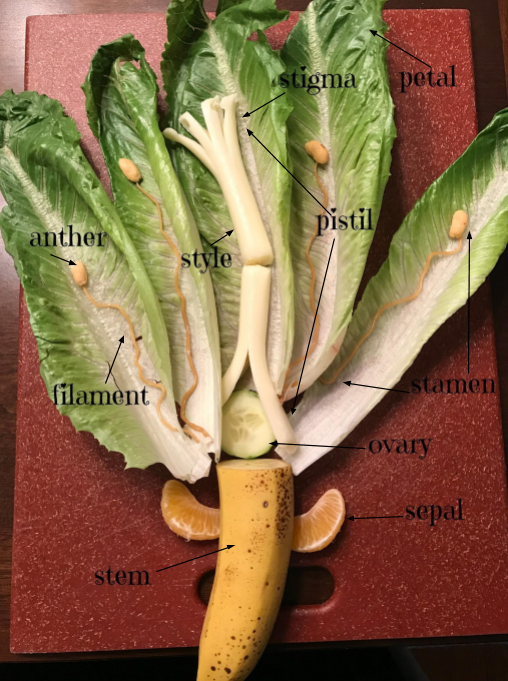
My understanding of the cognitive tool of modeling is to think dimensionally about a stimuli. My overarching topic is plants, so for this assignment I chose to focus on the parts of the flower. Students in my class would be expected to know the parts of a flower as seen in the diagram below.
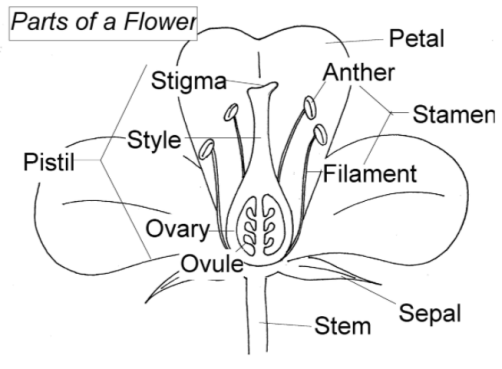
Image retrieved from http://www.gridgit.com/post_rose-flower-plant-diagram_361009/
Generally, we would explore this topic in 2D. However, a real flower is 3D so students would have the opportunity to “look at” an actual flower. Creating a model would allow students to experience the material in a new way. Creating a model forces students to actually build the parts of a flower. In my model I have zoomed in on the flower to explore the intricate pieces inside. My model is a larger version of the actual size. So, while my version is larger, I still had to make sure that the pieces were proportionate. While creating my model I had to really be in tune with the shape and size of each part. For example, the filament is very thin and should fit within the petals. I also had to think about the ways that the parts connect. My initial version that I had drawn out had to be changed because it was disproportionate, but I didn’t realize this until I actually started building. I had to think about the ways I could manipulate the materials. For example, I had a really hard time coming up with a food item to be the pistil. Then I thought about the ways I could pull apart the string cheese to change the way it looked.
Building this model definitely allowed me to perceive the parts of a flower in a different way. I had to think about shape, order, size, proportion, etc.. All things that I would not have thought about otherwise. When I close my eyes I can picture the model that I created. I know what foods I used for each part. From memory, I could use my model to draw a parts of a flower diagram. I would hope this experience would be the same for students. Creating the model allowed me to connect with the material in a way that I would remember.
I would love to see the models that students would create if they were given this task. I would imagine that I would get a very diverse array of models. As I was exploring this topic and making decisions about my model I noticed that I was connecting with many of the previous thinking tools we’ve explored. The Root-Bernsteins state “modeling is a higher-order thinking tool dependent upon the skilled use of many of the tools discussed in this book” (1999, p.230). To me, this means that modeling is a great tool to help develop and/or demonstrate a deep understanding of topics.
References
Root-Bernstein, R. S., & Root-Bernstein, M. (1999). Sparks of genius: the 13 thinking tools of the world’s most creative people. Boston, MA: Houghton Mifflin.
How Do I Love Thee: Embodied Thinking
Embodied Thinking – A Photosynthesis Play
For this assignment, students will use their bodies to act out the process of photosynthesis. There are seven roles: sun, plant, water, carbon dioxide, oxygen, glucose, and a narrator. Students would wear tags that identify which role they are playing. I would allow students to represent each element using their bodies however they felt appropriate, but you will find my examples below.
Sun (stands on a stool high above the other parts with arms outstretched, fingers wiggling)- The sun sends his energy to the plant.
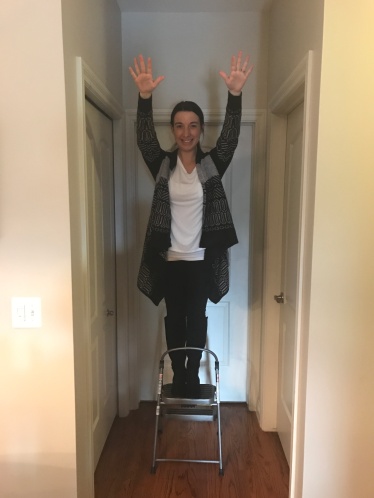
Plant (stands straight with arms on either side, palms up, may tilt side to side)- The plant absorbs, sunlight, carbon dioxide, and water.
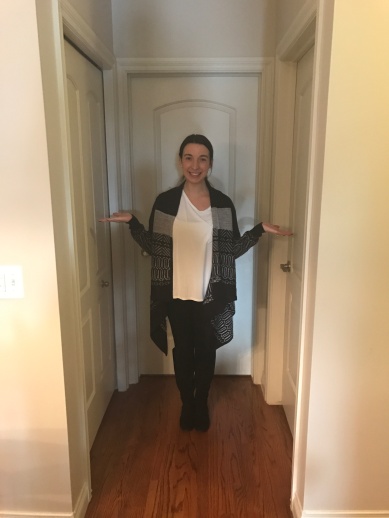
Water (lays on the ground near the feet of the plant, wiggles back and forth)- Water is taken in through the roots on the plant.
Carbon Dioxide (holds hands with the plant to represent entry through the leaves)- Carbon dioxide enters through the leaves.
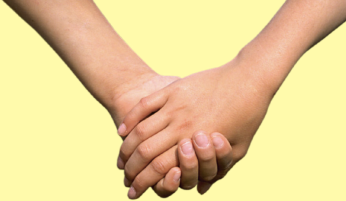
Glucose (appears only after the plant has absorbed water, sunlight, and carbon dioxide, this person moves around the “plant” outlining the body to represent movement throughout the plant)- The plant uses these ingredients to make food (or glucose) and this is transported throughout the rest of the plant.
Oxygen (appears only after the plant has absorbed water, sunlight, and carbon dioxide, starts side by side with the plant, when the plant burps he moves away)- Oxygen is released by the plant.
Narrator- Reads the steps to photosynthesis as the other students act them out.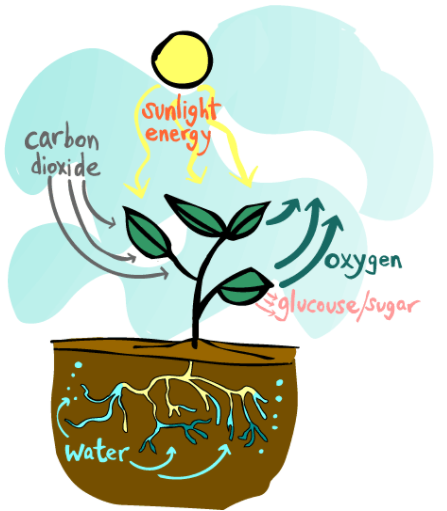
Image retrieved from: http://www.sheppardsoftware.com/content/animals/kidscorner/foodchain/photosynthesis.htm
My understanding of the cognitive tool of embodied thinking is that it is using your body to become the stimuli. I was a dancer for 15 years so I felt that this topic was easier for me to connect with than some of the others. I enjoyed watching the Math Dance video, as it is something that I can relate to.
Photosynthesis is a science concept and not something that we would generally think of using our bodies. Most often we think of these concepts as very concrete, so it still was a bit of a challenge for me to think about the concept using my body. Photosynthesis is a process that I teach my fourth graders every year during our unit on plants. Even though we can observe plants, we can’t actually see photosynthesis happening. This is why I thought it would be a good topic to embody.
While the examples above are my embodiment of the process of photosynthesis, I would imagine that my students’ representations would be very diverse. I feel that if students are embodying the parts of photosynthesis it will aid in their connection to the process and in turn create a better overall understanding. As the ancient Chinese proverb reads on page 181 “I hear and I forget. I see and I remember. I do and I understand” (Root-Bernstein, 1999). If students are using their bodies to represent photosynthesis than they are connecting with the material in new ways.
On page 162, the Root-Bernsteins state “it is possible to conjure up feelings of body tension or touch or movement in the mind, but most of us overlook these imaginative feelings because we are trained so early to see them or translate them into descriptive words” (1999). It is interesting to think about the way we train our brains to be a certain way. I think back to when I taught kindergarten and how most of the learning we did connected to our bodies and/or movement. For example, when I taught sight words I had students create a body movement with every word. This proved to be an effective way to help students remember their words. As students get older, we do less and less of this. I would predict that embodiment would be easier for a child than an adult. The real question is, why do we fight this? Embodied thinking should be part of our everyday practice as teachers, as it clearly leads to better understanding.
References
Root-Bernstein, R. S., & Root-Berstein, M. (1999). Sparks of genius: the 13 thinking tools of the world’s most creative people. Boston, MA: Houghton Mifflin.
The Creative “I”-Variations on a Theme
This assignment was definitely more challenging than I had anticipated. I initially thought “I got this”, it won’t take me that long, but wow was I wrong. Rewriting a song proved to be a difficult task. Let’s just say, I have a whole new respect for songwriters. At first, I just used the words to the song and tried to recreate words using the same amount of syllables. I quickly realized that wouldn’t work and it was much more about the tune of the song. I eventually got the hang of it and it seemed to flow more freely.
I never realized what a huge role experience plays in the development of creativity. In “Twisting knobs and connecting things: Rethinking Technology & Creativity in the 21st Century” by Danah Henriksen, Punya Mishra, & the Deep-Play Research Group Michigan State University they talk about how “the trick in developing creative thinkers is to provide people with a rich range of ways of understanding and experiencing” (2014). This is a new idea for me, as I had never really thought about the ways that experience affects creativity. So, if I want to help my students to become more creative I can do so by providing them with “rich experiences with art and science, with open-ended experiences that encourage the making of deeply personal connections across knowledge domains” (2014).
The original lyrics to the song “Firework” by Katy Perry are on the left and on the right are the lyrics I created based on“Twisting knobs and connecting things: Rethinking Technology & Creativity in the 21st Century” by Danah Henriksen, Punya Mishra, & the Deep-Play Research Group Michigan State University.
Do you ever feel like a plastic bag Creativity, what does it mean?
Drifting through the wind Is it mystical
Wanting to start again Or is it a real life thing
Do you ever feel so paper thin Creativity, how does it work
Like a house of cards Can we nurture it
One blow from caving in Or is it all set in
Do you ever feel already buried deep The ability to see one thing
Six feet under screams And make a change
But no one seems to hear a thing That no one else could see
Do you know that there’s still a chance for you Use your experience and what you know
‘Cause there’s a spark in you Be unpredictable
You just gotta ignite the light Anyone can train their brain
And let it shine To build on old
Just own the night With new light
Like the fourth of July Create a prepared mind
‘Cause baby you’re a firework You know you’re creative
Come and show ’em what you’re worth Use that inspiration
Make ’em go “oh, oh, oh!” Twisting knobs like whoa, whoa, whoa
As you shoot across the sky-y-y Make it novel, effective, whole-oh-oh
Baby you’re a firework Build a combination
Come and let your colors burst Use any variation
Make ’em go “oh, oh, oh!” Use what you know, know, know
You’re gonna leave ’em falling down down down Past experiences help you grow, grow, grow
You don’t have to feel like a waste of space The trick to thinking like Darwin
You’re original, cannot be replaced Is to understand in different ways
If you only knew what the future holds Making personal connections
After a hurricane comes a rainbow Across disciplines and situations
Maybe a reason why all the doors are closed Create an optimized cerebral climate
So you could open one that leads you to the perfect road Where creativity is inspiring
Like a lightning bolt, your heart will glow Make a change, manipulate
And when it’s time, you’ll know It’s the way to operate
You just gotta ignite the light Anyone can train their brain
And let it shine To build on old
Just own the night With new light
Like the fourth of July Create a prepared mind
‘Cause baby you’re a firework You know you’re creative
Come and show ’em what you’re worth Use that inspiration
Make ’em go “oh, oh, oh!” Twisting knobs like whoa, whoa, whoa
As you shoot across the sky-y-y Make it novel, effective, whole-oh-oh
Baby you’re a firework Build a combination
Come and let your colors burst Use any variation
Make ’em go “oh, oh, oh!” Use what you know, know, know
You’re gonna leave ’em all in awe-awe-awe Past experiences help you grow, grow, grow
Boom, boom, boom Fuse, fuse, fuse
Even brighter than the moon, moon, moon Put ideas together and boom, boom, boom
And it’s always been inside of you you you Build on what exists and make it new, new, new
And now it’s time to let it through Create with style and value
‘Cause baby you’re a firework You know you’re creative
Come and show ’em what you’re worth Use that inspiration
Make ’em go “oh, oh, oh!” Twisting knobs like whoa, whoa, whoa
As you shoot across the sky-y-y Make it novel, effective, whole-oh-oh
Baby you’re a firework Build a combination
Come and let your colors burst Use any variation
Make ’em go “oh, oh, oh!” Use what you know, know, know
You’re gonna leave ’em all in awe awe awe Past experiences help you grow, grow, grow
References
Henriksen, D., Mishra, P., & the Deep-Play research group (2014). Twisting knobs and connecting things: Rethinking Technology & Creativity in the 21st Century. Tech Trends, (58)1, P. 15-19
Abstracting and Analogizing
Fully understanding the idea of “abstracting” was definitely a bit more abstract for me than some of the other ideas we have looked at in the course. Physicist Werner Heisenberg states, abstracting is “the possibility of considering an object or group of objects under one viewpoint while disregarding all other properties of the object. The essence of abstraction consists in singling out one feature, which, in contrast to other properties, is considered to be particularly important” (Root-Bernstein, p.72). So, once again we are looking at an ordinary topic through an unordinary lens. This is difficult. One idea that really stuck with me from the reading was people “can identify abstracting when they see it, but very few can actually tell you what makes abstract art abstract” (Root-Bernstein, p. 72). This reminds me of a time when I was trying to create a general rubric for creativity. I felt like I knew creativity when I saw it, but I couldn’t pull apart the elements that actually made a piece creative. This makes things especially challenging when trying to grade students on something that you can’t really explain. Over time, I have come up with a more reasonable and reliable rubric for creativity (strongly following the work of Mishra and Henriksen) but, I continue to tweak it. Abstracting reminds me of this. Like creativity, it is something that we see all the time, but the dynamics of it are not crystal clear.
My larger overarching concept is plants. For this assignment I chose to focus on pollination and the moment the bee picks up the pollen from the flower. I chose this topic because it is a necessary element to life as we know it. For the first part of the assignment I chose to abstract the topic by writing a poem from the viewpoint of the flower. For the second part of the assignment I chose to analogize the topic by creating a simulation for my students. In order to complete these two tasks I watched several videos in slow motion of bees landing and picking up pollen from plants. I went through several versions of abstracting before I found something that felt right.
Pollination plays a large role in life on our earth. Without pollination, plants would not reproduce, which in turn would affect our entire planet. The moment a pollinator (or bee) picks up pollen from a plant is a key step in the process of pollination. It is also an interesting one. By zooming in on this particular moment, it would allow students to connect with the importance of this simple step in pollination. We know that exploring topics through multiple senses leads to deeper understanding for students.
Here is my poem, abstracting pollen being picked up from the viewpoint of a flower:
Alone I Wait
Alone I wait
for the tiptoeing beast
At my expense
he will have his feast
Alone I wait
for a single dance
My delicate filament
don’t stand a chance
Alone I wait
for the sticky straw
To slurp away
with his toothless jaw
Alone I wait
for the dusty bee
To silently take
a part of me
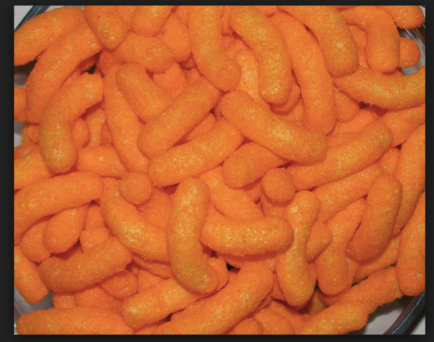
How does rubbing a cheese puff relate to pollination? That is exactly what I want my students to figure out. According to Robert and Michele Root-Bernstein, “analogies recognize a correspondence of inner relationship or of function between two (or more) different phenomena or complex sets of phenomena” (p.142). To help students understand what it would be like to be a bee picking up pollen during pollination, I have created this analogy between two different phenomena. Students will need three materials, a juice box, cheese puffs, and a paper flower. For this analogy, students will become the bee, the juice box is the nectar, the cheese puff is the pollen, and the paper flower is the flower. As students drink from the juice box, they will rub their fingers on a cheese puff and the cheese will transfer to their hands (as a bee would pick up pollen while drinking nectar). Then they will “fly” to another student’s paper flower and rub their fingers on the flower, thus transferring the pollen to another flower.
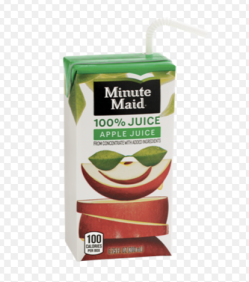
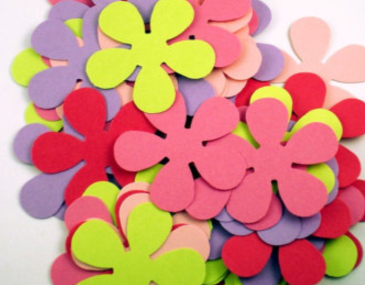
Patterning
This week in CEP 818, we were asked to examine the idea of patterning. My understanding of the cognitive tool of patterning is that it is a repetitive form or plan to something. Patterns are all around us. “Every moment of every day we organize the random events we see, hear, or feel by grouping them” (Root-Bernstein, 1999, p.92). It’s interesting to think about the actual number of patterns we come in contact with in a day. As someone who loves organization, I can say that I truly appreciate the art of patterning.
Identifying Patterns
There are many patterns within my chosen focus area of plants. The patterns that stand out the most are the patterns I use to help students classify different kinds of plants. In class we talk about plants that make seeds vs. plants that don’t make seeds, gymnosperms vs. angiosperms, vascular vs. nonvascular, etc.. We look a pictures and I explain the characteristics of each. Students take notes and are eventually expected to be able to sort the plants on their own. I have always viewed this as being helpful to their learning. I provide them with the information they need to determine which category each plant falls under. However, after reading this week’s chapters in Sparks of Genius The 13 Thinking Tools of the World’s Most Creative People, I’m beginning to think that finding the patterns for them may actually be hindering their learning.
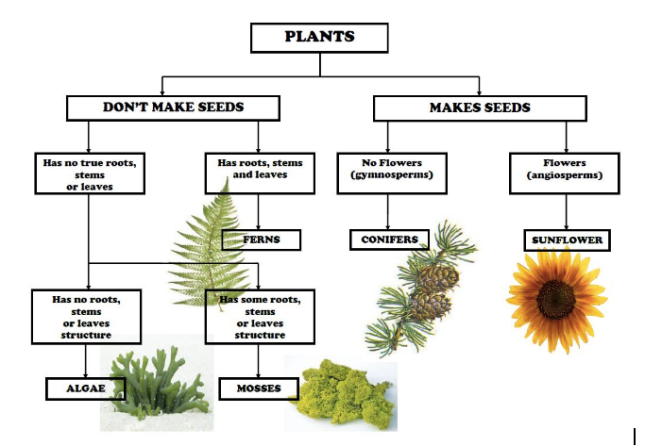 Image Retrieved from https://imanshomeschool.wordpress.com/2013/05/01/plant-classification-chart/
Image Retrieved from https://imanshomeschool.wordpress.com/2013/05/01/plant-classification-chart/
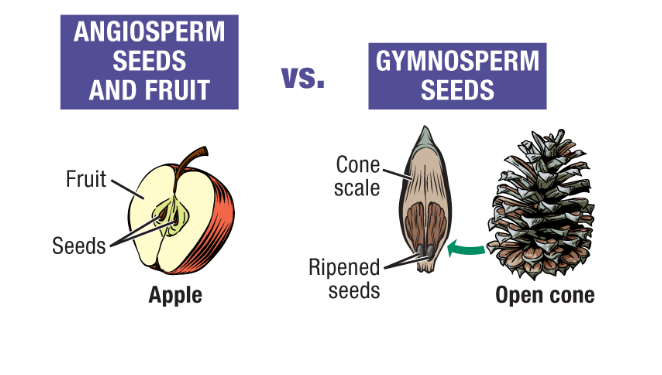 Image Retrieved from http://way2usefulinfo.blogspot.com/2013/01/some-differences-between-angiosperms.html
Image Retrieved from http://way2usefulinfo.blogspot.com/2013/01/some-differences-between-angiosperms.html
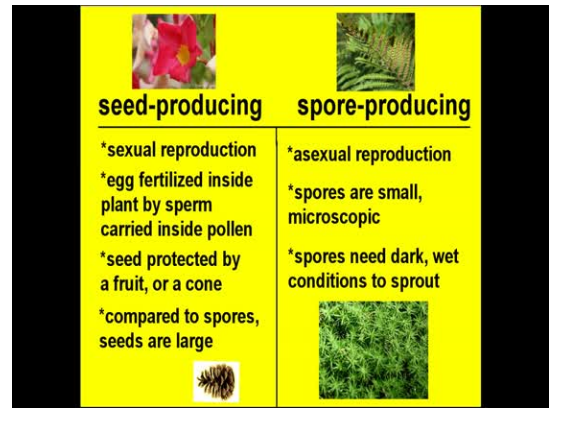
Image Retrieved from https://www.schooltube.com/video/5b5558f62d4846bf81f2/Seeds%20and%20Spores
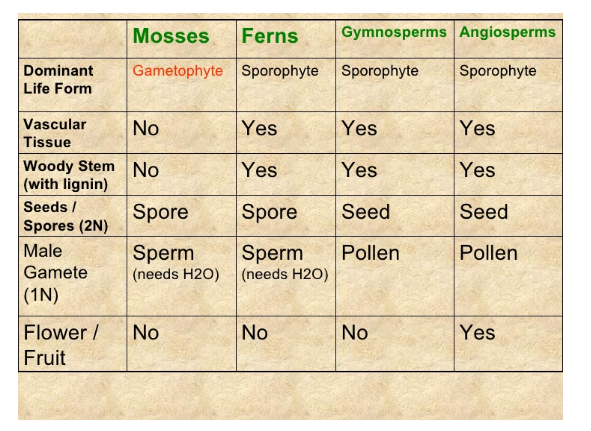
Creating Patterns
“There are so many ways of looking at the same object or idea, yet most of us see only one way” (Root-Bernstein, 1999, p.102). This got me thinking, why should students be confined to the patterns I see (or the patterns that have been identified for me) in plants? We know that the best way to find patterns is through multi-sensory observation (Root-Bernstein, 1999, p. 99). My re-patterning idea is to provide students with pictures, videos (and other digital tools), actual plants, and nature walks where they are using all their senses to find patterns in plants. While most of my observations have relied heavily on sight, this would allow the students to experience the plants in a new way. For example, they might notice that certain plants are rough while others are smooth or that some plants smell sweet while others do not.
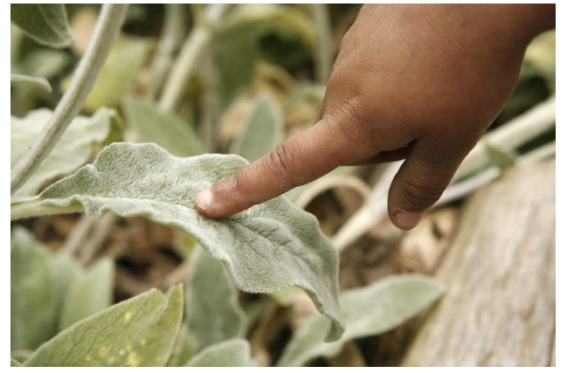 Image Retrieved from serenityinthegarden.blogspot.com
Image Retrieved from serenityinthegarden.blogspot.com
My prediction is that students would find several patterns that I had never even thought about. Students would gain deeper understanding through their own exploration. I love the idea of empowering students to discover the content on their own. I know that by re-patterning this topic, students would be more engaged and in the end would be able to classify plants in a way that is meaningful to them.
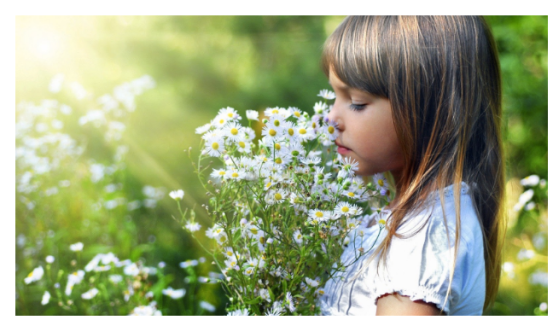 Image Retrieved from http://paper4pc.com/
Image Retrieved from http://paper4pc.com/
References
Root-Bernstein, Robert & Michele. (1999). Sparks of genius the 13 thinking tools of the world’s most creative people. Houghton Mifflin Company. New York, New York.
Creativity Interview
If someone asked you to define creativity, what would you say? How do you decide if something is creative? Do you just know it when you see it? After reading A NEW Approach to Defining and Measuring Creativity, I explored these and other ideas through an interview with a person that I would consider to be creative. A synopsis of my interview can be found here.

Image retrieved at http://www.blogs.jbs.cam.ac.uk/socialinnovation/2015/06/26/embracing-passion-and-creativity/
Perceiving
In fourth grade, one of the units we teach in science is on plants. For this activity, I chose to focus on an object that becomes well known to all my fourth graders throughout our unit of study. It is the parts of a flower model. The model can be seen in the image below.
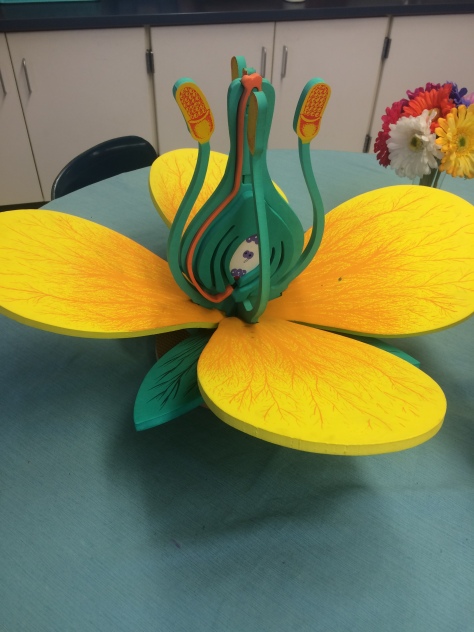
Obviously, the first sense that this object appeals to is our sense of sight. It is large and colorful and always catches student interest right away. One of the learning targets in this unit is for students to know the parts of a flower. I thought about how most of the time we are looking at a 2D model of a flower and practicing labeling the parts. In Sparks of Genius The 13 Thinking Tools of the World’s Most Creative People, Robert and Michele Root-Bernstein state “the keenest observers make use of every kind of sensory information” (1999, p. 40). This pushed me to perceive the flower model in a new way. Using my five senses, I re-imagined the model. I listened as my hands touched the foam, closed my eyes as I felt the pieces, and even took note of how the model smelled.
Taking it one step further, I was curious as to how this might impact student learning. I thought about how I could have my students perceive the model in a new way. I decided to set up a little experiment. We have not yet begun our unit on plants, so I decided to teach a few parts of the flower in different ways and see how the results varied. Three students participated in this activity. All students were asked to label the same four parts of the flower: the sepal, stamen, stigma, and ovary. For the first student, I pointed to the different parts on the model and asked her to repeat them to me.
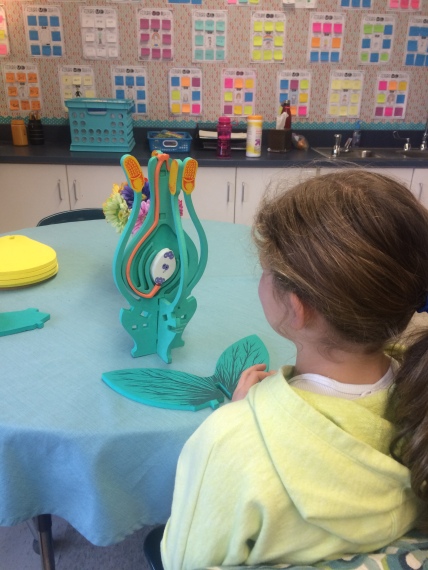
For the second student, I used a blindfold and asked her to only touch the different parts as I told her the part name.
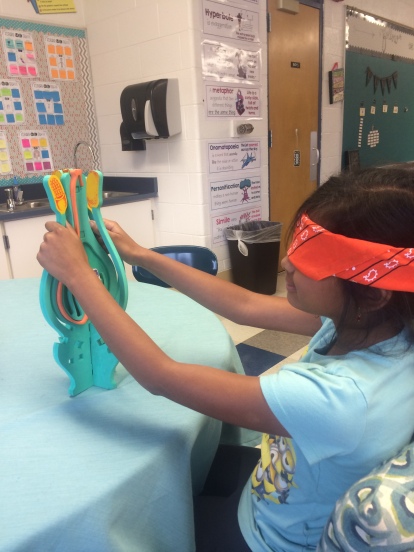
For the last student, I asked him to look at and feel each part as we went through the names.
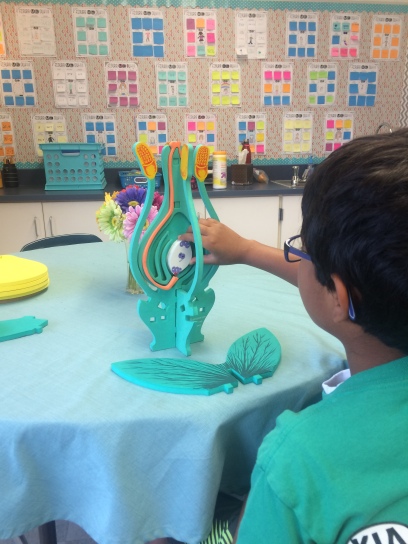
The student who only used her sense of sight was able to rename two parts independently. The student who only used her sense of touch was also able to rename two parts independently. But, the student who used both sight and touch was able to rename all four parts independently. More testing would need to be done, but it seems that learning increased when the student was able to perceive the object in more than one way.
My understanding of the cognitive tool of perceiving is essentially observing something in a new way. During my initial observation of the model, I relied solely on my sense of sight. My observations were of the surface (the colors, lines, and shapes) and that was pretty much it. Robert and Michele Root-Bernstein actually warn us against relying on any single sense as a basis for observation (1999, p. 38). During my second observation, I relied on my sense of sight, touch, smell, and hearing. This helped me to perceive the model in a completely different way. I had never paid attention to the way the pieces felt or fit together. I definitely had never consciously thought about the foamy smell of the model or how the pieces sounded when I touched them or when they were rubbed together. Experiencing the model in this way forced me to actively observe the object instead of just passively look at it. This idea of perceiving objects in new ways can be extremely beneficial to teaching and learning in my classroom. As the classroom teacher it will allow me to connect deeper with the content and hopefully engage students in new ways. Giving students the opportunity to perceive in new ways will hopefully lead to the discovery of new ideas and a deeper understanding of topics. I love the quote in the reading from Biochemist Szent-Gyorgyi, “Discovery consists of seeing what everybody has seen and thinking what nobody has thought”.
References
Root-Bernstein, Robert & Michele. (1999). Sparks of Genius The 13 Thinking Tools of the World’s Most Creative People. Houghton Mifflin Company. New York, New York.

